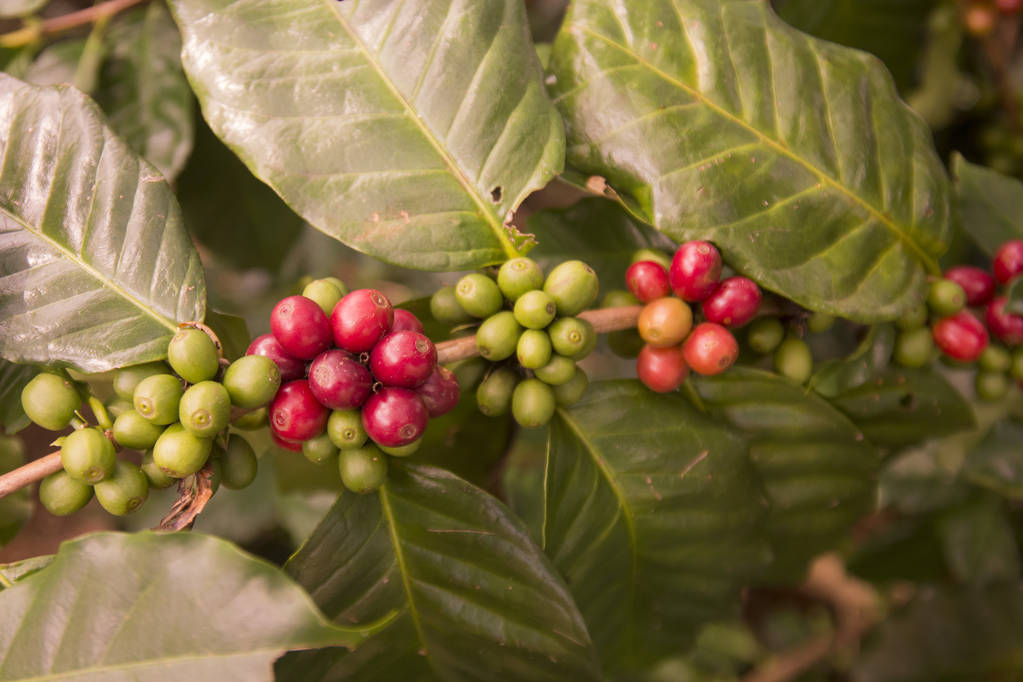Coffee is one of the most popular hot drinks worldwide and has been enjoying increasing popularity for centuries.

The origin of the coffee is very different depending on the variety. Nowadays it is produced worldwide and new growing areas are being created every day.
The enjoyable guardian convinces with a very individual taste and is available in many varieties. Even if it is an integral part of everyday life for many, most of them hardly know exactly where the growing areas of coffee are. Therefore, we go on a journey through the most popular coffee cultivation areas and also take a closer look at the two main varieties Robusta and Arabica.
The growing areas of coffee extend over the entire globe. The coffee beans we use come from the coffee plant. This is one of the rather sensitive plants and only thrives under optimal climatic conditions. Countries that are near the equator are preferably suitable for this. Together these areas result in a so -called coffee belt. The predominantly tropical and moist growing areas enable the coffee plants to grow excellent and a quick heyday. The two economically represented coffee types are the Coffea Arabica (Arabica) and the Coffea Canhora (Robusta). Arabica takes up the largest proportion of the growing areas with around 75 % and is the most popular worldwide among all coffee drinkers. But other coffee plants such as the Coffea Liberica, Coffea Stenophylla, Coffea Congensis and many more can be found in the vastness of the growing areas. Well -known places where coffee plants are bred are Brazil, Ethiopia, Nicaragua or Sumatra.
These are the most important production countries
The largest production countries of coffee are near the equator and together form the so -called coffee belt. Expressed, the areas of Central and South America, Africa and parts of Asia’s crucial cultivation areas are primarily to be put. The largest production countries form Brazil, Mexico, Panama, Guatemala, Vietnam, Thailand, Angola, Congo, Liberia, Colombia, Bolivia, Peru, Venezuela, the Central African Republic, Costa Rica, Zambia and many more. In all places there are more or less optimal conditions for a coffee harvest. A billion -dollar industry has developed around the coffee today. The production countries increase their growing potential every day and thus meet the increasing demand for coffee. However, the individual growing areas do not all produce the same coffee. There are significant differences between quantity, cultivation and taste. On the one hand, this is due to the respective climatic conditions, and on the other hand also due to the differentiated cultivation methods. A Arabica coffee bean, which comes from Africa, therefore tastes very different from an Arabica coffee bean, which comes from Asia, for example. The variety of coffee is sometimes a reason for its popularity and offers every coffee drinker daily variety and aromatic wealth. Below we list the most important growing areas of coffee and discover their special features.
Coffee growing areas in North and Central America
In North and Central America, Nicaragua in particular stands out as a coffee growing area. In the El Salvador and Santo Domingo regions there are numerous plantations that extend over miles and accommodate a wide variety of coffee plants. Many people in these areas live exclusively from coffee cultivation. The valuable coffee beans are shipped all over the world after harvesting. Another special cultivation area is Jamaica. Here the famous “Blue Mountain coffee” is bred. For this reason, the Blue Mountains from Jamaica are covered with large -scale coffee plantations. However, the excellent type of coffee has its price and has just under $ 120 per kilogram. Blue Mountain coffee is one of the most expensive varieties in the world. Tourists from all over the world visit the growing areas to take smaller quantities with you and try out the delicious coffee.
The state of Mexico is located in North America and parts of Central America. Here too, coffee is grown on large plantations. There are around 400 million coffee trees in one of the most important growing areas, Soconusco. This tremendous amount is expanded by other growing areas across the country. As a result, Mexico rises in the top ranks of the largest production countries. With the “Ruta del Café”, even a separate coffee road was established, with which the tourist value of the coffee -shaped landscape is to be increased. In addition to Mexico, growing areas from Costa Rica, Hawaii and Guatemala can also convince with tasty and famous types of coffee. Costa Rica scores particularly with aromatic, full -bodied flavors and intensely fragrant coffee. Hawaii is ideal for the coffee harvest, as optimal climatic conditions prevail here. The coffee beans from there have a mostly mild and nutty aroma. Finally, the most populous state of Central America is on the plan: Guatemala. The country has always been one of the most important production countries for coffee and produces coffee beans with an aromatic and spicy note. With altitudes around 2,000 meters and extremely fertile, volcanic nutrients, coffee trees grow particularly quickly here. This leads to high quality and first -class diversity.

Coffee growing areas in South America
South America is the continent with the strongest production countries for coffee. The two strongest countries are Colombia and Brazil. The coffee plant has developed into a real economic miracle and gives the population in addition to many jobs, but also new cultural diversity. The climate in the warm areas is constant all year round and provides the coffee harvested optimal conditions for high -quality cultivation. The ARABICA and Robusta coffee varieties are particularly well represented here and are distributed all over the world by central trading points. Dozens of tons of coffee from South America also arrive every day in Europe. In addition to Brazil and Colombia, places such as Ecuador, Venezuela, Peru and the Galapagos Islands also play an important role. Each location convinces with individual advantages and a large variety of varieties.
Brazil produces around 34 % of the world’s total coffee requirement and is therefore considered a real heavyweight among production countries. The growing areas of coffee extends across the country and are largely responsible for economic success. With almost 287,000 farms on approx. 2,402,933 hectares on which coffee is grown, Brazil leaves all colleagues far behind. A single farm can be up to 25,000 hectares. The cultivation areas deliver around 45 million sacks with coffee beans every year, with each sack weighing about 60 kilograms. With 80% harvest content, Arabica beans are mainly bred. The remaining 20% are robusta beans. The success of the coffee in Brazil is not only in sales alone. The Brazilians use a fifth of their harvested beans for their own use. Coffee has developed into a true culture in Brazil. In private and business areas, it is a good tone to offer your guest a coffee. A whole third of the exported raw coffee also goes to Germany and thus ends up directly on our domestic tables.
Behind Brazil and Vietnam, Colombia is the third largest coffee exporter worldwide in the list of the largest production countries. Coffee has traditionally been grown here for almost 300 years. More than half a million Colombian live from the industry and thus represent a driving force of the local economy. Even though Colombia had recorded a declining production in recent years and has even been replaced by Vietnam to third place, coffee plays one Important role for the people living there and the entire nation. Coffee is considered a cultural drink in Colombia and sometimes shapes society. The coffee farmers attach great importance to the quality of their coffee beans and breeds only the best standards. The country’s biologically high -quality cultivation distinguishes the country from many other production countries and makes “coffee made in Colombia” a strong branded product.
Incidentally, particularly popular coffee also comes from the Dominican Republic. With this country, people associate sun, palm trees, beach and sea – the perfect Caribbean goal for an exuberant vacation. However, coffee is also grown here in large masses. There are almost 50,000 smaller coffee producers, which are scattered across the entire country. Because of the high temperatures in the north (30 degrees Celsius on average), the profitable growing areas are largely in the somewhat cooler south. Almost all production facilities specialize in the cultivation of Arabica coffee beyond this.


